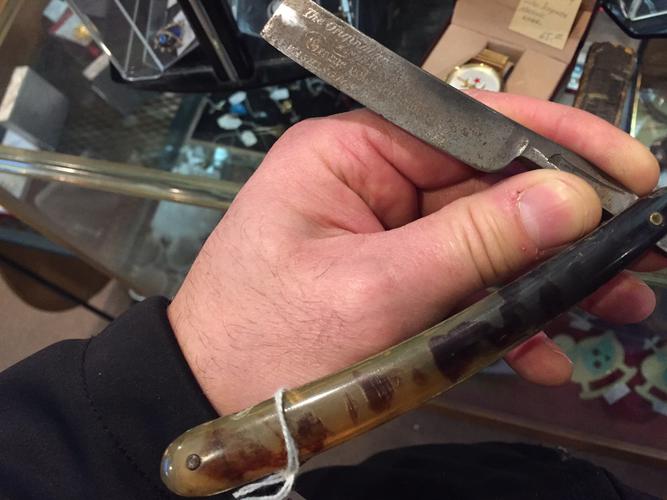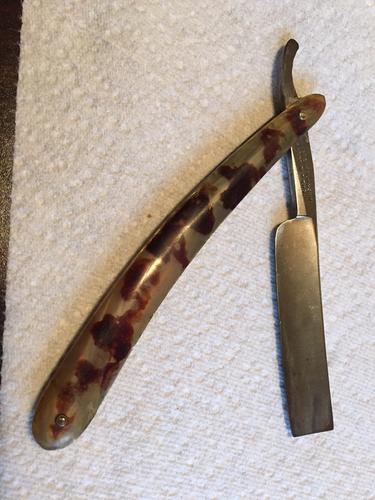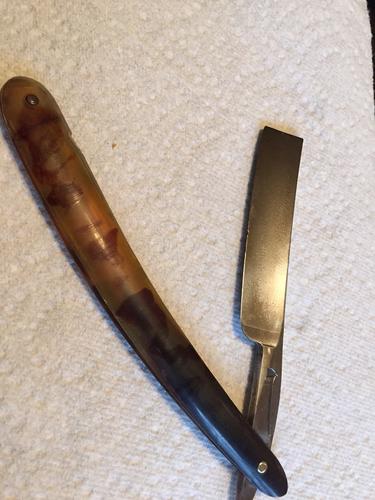Results 1 to 6 of 6
-
12-28-2015, 09:13 PM #1Senior Member

- Join Date
- Oct 2015
- Location
- Pittsburgh, PA
- Posts
- 212
Thanked: 21 George Wolstenholm and Sons light restoration
George Wolstenholm and Sons light restoration
Hello everyone!
I'm a newbie, and just purchased a couple of razors today. One is a George Wolstenholm and Sons. Looked ugly in the antique shop, but brought it home and used some Maas, and got rid of the vast majority of the rust. What is left is a fairly shiny blade with a chip in the edge that I need to remove, and some scales that need attention.
I have two questions:
1. I know I need to remove the gouge in the razor. I've viewed gssixgun's tutorial, but I don't have a DMT to breadknife the razor. I also saw this demo on youtube that looks doable and effective:
Has anyone tried this method with success?
2. The scales are in decent shape. Not sure if they are tortoise shell, or horn stained to look like tortoise shell, or plastic...I believe they are original scales. Anyway, I saw a thread where someone soaked the scales in neatsfoot oil to bring back the sheen. Is this recommended? Also, any thoughts on what I might want to consider to smooth out some of the small chips in the scales? There are no cracks, so I'd like to salvage the scales if possible.
Thanks everyone!


-
12-28-2015, 09:26 PM #2Senior Member

- Join Date
- Dec 2014
- Location
- sheffield
- Posts
- 554
Thanked: 55
Honestly you're probably better sending it out to a pro for the heavy work and learning to hone a straight by doing touch ups. You are quite likely to ruin a decent razor your first try at such extreme work. (I did, and am also still putting some seriously uneven hone wear on my practice razor). Razors are very different to knives.
Will leave the practical advice to more experienced gents.Last edited by dmnc; 12-28-2015 at 09:29 PM.
"Ignorance is preferable to error, and he is less remote from the truth who believes nothing than he who believes what is wrong."-Thomas Jefferson (Notes on Virginia, 1782)
-
12-28-2015, 09:29 PM #3

The sandpaper method will work just fine. However your blade has a bit of a smile (a good thing) that would want to preserve. As far as soaking in neatsfoot oil; it works great but you would want to do any repairs to the scales prior to soaking. Once it has been soaked, superglue does not stick very well.
The older I get the more I realize how little I actually know.
-
01-02-2016, 01:31 AM #4Senior Member

- Join Date
- Oct 2015
- Location
- Vermont
- Posts
- 167
Thanked: 8
If you haven't already fixed it, I'd just throw it on the 1k and do some regular honing, then kill the edge and do it again.that small chip will most likely hone out pretty quick. Gssixgun bread knife technique works great as well and would knock that chip out quick. I've done it both ways and they were both effective. Nice score by the way! I am really partial to wostenholms blades. They're great. Good luck man
-
01-02-2016, 05:02 AM #5

That's a nice find! I would also recommend sending it out to a pro and learning how to hone (especially with chips) on a lesser razor. If you need a recommendation GSSIXGUN (Glen) is a great guy and will take care of you quickly.
You did a nice job of making the blade look better without removing the etch. As for the scales, try lightly sanding them to remove small chips and scratches. Take your time and enjoy the process
-
01-02-2016, 06:37 AM #6Senior Member




- Join Date
- Nov 2012
- Location
- Across the street from Mickey Mouse in Calif.
- Posts
- 5,320
Thanked: 1184
I do all my chip removal on the edge of a hone and go the other direction. Easier for me to keep the blade profile and I don't worry so much about cracking the blade. I always bread knife a little but am more comfortable going toe to heel on the edge of a 1k. That chip I would start out at 500 light strokes.
Good judgment comes from experience, and experience....well that comes from poor judgment.


 2Likes
2Likes
 LinkBack URL
LinkBack URL About LinkBacks
About LinkBacks






 Reply With Quote
Reply With Quote
